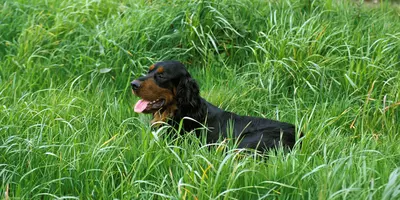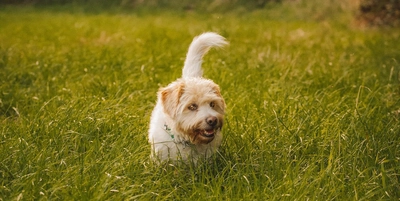Best Dog Food for Arthritis
- 21 Dec 2019
- 5m read

When dogs who were once enthusiastic squirrel-chasers start to lose their mojo, it might be a sign of arthritis. This is a very common condition among older (but not necessarily wiser) pooches as they start to slow down. Pet parents might be alarmed, but with a few lifestyle changes, in most cases, it can be managed.
The chances are, you'll know a human or two with arthritis. So you'll be aware that with a little extra help, life can carry on pretty normally for your arthritic dog. With a healthy diet, some gentle exercise and a cosy home environment, your pup will be more at ease. Let's take a closer look at arthritis in dogs, and how a Butternut diet can form part of their everyday health management.
What Causes Arthritis in Dogs?
Arthritis in dogs is an inflammation of the joints, caused by the bones rubbing together. The bones in a healthy joint slide over each other easily, but in an arthritic joint, the worn and uneven surfaces can't glide, resulting in uncomfortable swelling. Arthritis in dogs is common, and although it can happen at any age, tends to creep up on our older four-legged friends. Joints become stiff and painful, and catching the frisbee might be a bit trickier than it once was.
Some breeds are more prone to developing arthritis than others. If you live with a Lab, German Shepherd or Springer, for example, it's worth keeping an eye out for stiffness or an awkward gait so you can start managing the condition early on.
Being overweight can also cause dogs to develop arthritis due to the excess pressure placed on their joints. Adipose tissue (also known as fat cells) release chemicals and signals that contribute to chronic low grade inflammation.Weight management is one of the keystones to pain relief, according to the expert team at Canine Arthritis Management. If you suspect that your pooch falls on the chubbier side, it might be time to try and shed some pounds or their arthritis could get even worse.
Signs of Arthritis in Dogs
Some of the common signs of arthritis include:
• Stiffness
• Less interest in exercise
• Frequently licking painful joints
• Limping whilst exercising
• Tiredness
• Behavioural changes, e.g. don't let you touch their back legs
Arthritis Treatment for Dogs
Your vet will most likely prescribe your dog anti-inflammatory drugs or advise a supplement rich in omega-3 for joints, such as Algae.
Another big consideration is diet, as certain ingredients in dog food are essential to promote their wellbeing. A quality protein source will help to maintain strong muscle tissue which supports the joints. Turmeric is recognised as a particularly effective anti-inflammatory, pain-relieving spice and a little bit goes a long way.
How to Help a Dog with Arthritis at Home
Medication aside, there are a lot of steps you can take at home to help alleviate the symptoms of arthritis in your precious pooch.
Exercise is a really important part of arthritis recovery. It’s all about finding the balance between too much and too little. Too much exercise will place unnecessary strain on the affected joints, whilst too little exercise will cause muscles to become weaker and less able to support the joints. Your vet will be able to advise you on how much exercise your dog should be doing to suit their needs. With that in mind, it is best to avoid long walks when the weather is particularly chilly. Cold temperatures can cause joints to stiffen, making them uncomfortable.
If your pup is used to jumping up to hard-to-reach places such as the car boot, sofa, or your bed, it could be a good idea to install some ramps. Slippery surfaces which can cause your dog to slide can also put pressure on their joints, so we would recommend laying down some blankets or rugs to help them grip.
Make sure your pet has an extra-comfy bed in a warm spot. Cosiness can really help to relieve arthritic symptoms and under-bed heat pads aren't just about pampering – they're soothing, too.
Should You Walk a Dog with Arthritis?
Sometimes, older dogs prefer the sofa to the park. Which is understandable. You might have to encourage senior and arthritic dogs to take daily exercise, even if it's just a stroll to the post box to sniff out a message from a friend. This gets stiff joints moving and keeps brains working. Importantly, it also helps to prevent extra poundage sneaking up. Lack of activity = chubbiness. And it can put extra strain on arthritic joints, so it's important to carry on exercising.
Try to observe your dog whilst you are out on walks, they will find their own way of telling you that they’ve had enough. Good luck carrying them all the way home from the park.
Doing a gentle warm-up with your pooch before your walk (leotards and headbands not required) can help keep them flexible and stop them seizing up.
Why Butternut Box is Suitable for Dogs with Arthritis
Fortunately, there are plenty of ways to manage arthritis and make your pet more comfortable. A great way is to feed them a healthy diet which includes naturally beneficial ingredients. Butternut's Wham Bam Lamb recipe, for example, contains turmeric, which has been used for centuries in human health as an antioxidant that eases sore joints.
Maintaining a healthy weight is essential for taking the pressure off joints with arthritis. Doing this is all about balancing what goes in with what we burn off.
When you sign up to Butternut Box, we ask you lots of questions about your dog's lifestyle as well as their vital statistics (age, breed, talent for tricks). This is to help us put the right portion of food in their pouches, making sure their tummies are full and they've got the right amount of energy. A gentle walk, a Butternut Box meal and a nice spot on the sofa. We quite fancy that ourselves, now that you mention it.




